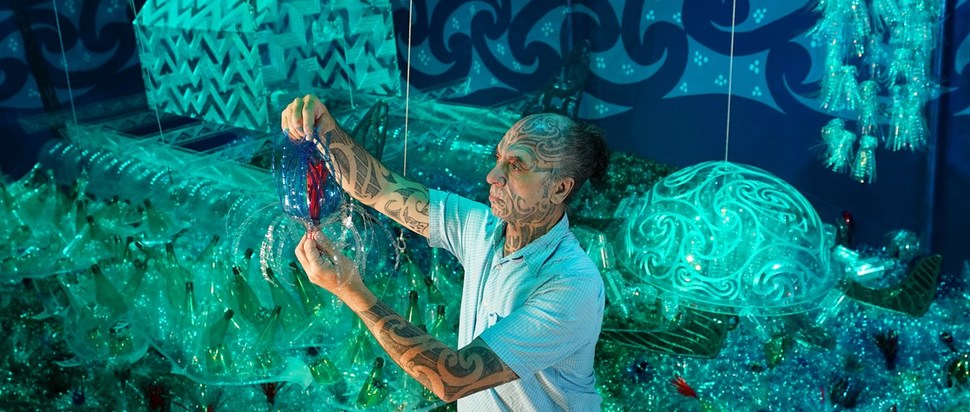Plastic Unfantastic: Rising Tide at The National Museum of Scotland
The National Museum of Scotland's latest exhibition explores the impact of the climate crisis on the islands of the Pacific – and highlights important environmental issues here in Scotland
Millions of years before dinosaurs roamed the earth, marine plants and algae died, sank to the seafloor and were buried until heat and pressure eventually transformed them into thick oil – fossil fuels. Today, we resurrect these ancient, entombed plants and chemically process them into plastic bottles, straws, medical equipment, fishing nets and more.
We all know what happens next – we use these products once and throw them away. Often, it’ll find its way back into the sea where its journey began some 400 million years ago. It’ll drift along currents to the shores of Hawaii, Kiribati, Tuvalu, or other Pacific Island Nations, threatening these communities and their ways of life. We see plastic as dirty, wasteful, a thing to be discarded and abhorred. Yet, we can’t seem to stop ourselves using it. George Nuku, an artist of Maori, Scottish and German descent, wants to change this perception. “It comes down to a question of value. Somehow we need to value this material more and, if we do, we’re going to be less inclined to throw it away,” he says. Nuku has created Bottled Ocean 2123, an immersive installation of a seascape crafted from plastic bottles, as part of the National Museum of Scotland’s exhibition Rising Tide: Art and Environment in Oceania. The exhibition highlights the scourge of plastic littering Pacific Island Nations, and the innovative and artistic ways Indigenous communities re-purpose it.
Nuku believes if we see plastic as treasure, the product of deeply ancient materials and dynamic processes beneath the Earth’s surface, then perhaps we’ll be less likely to discard it so thoughtlessly. “I speak plastic fluently. I know how to make plastic sing, to dance,” he says. “Plastic has qualities of transparency, of translucency. It reflects as well, we get to see each other through this light. I also speak polystyrene fluently. If transparent plastic is the equivalent of light and water, then polystyrene is like working with clouds.” Nuku created the installation with help from around 400 people across Edinburgh, including museum visitors, staff and volunteers from community groups. They helped cut and craft shapes of marine life from bottles to hang in the installation. He largely sourced the plastic himself, picking up litter from the side of the road: “For someone like me, you feel like you’ve won the lotto. It’s treasure, man. But when I see it, I’m assailed by the odour. It’s the smell of neglect.”
An investigation by The Ferret last year revealed scientists found microplastics in 80% of tested coastal water in Scotland over 2021 and 2022. Marine Scotland estimates over 90% of plastic in Scottish seas come from Scottish littering on land. So as plastic becomes ubiquitous in oceans, what role do artists play? Artists closer to home are already responding to this pressing issue. Julie Barnes, an artist from Aberlady, has taken a similar approach for the exhibition. Using 13,000 pieces of plastic waste found on East Lothian beaches, she unveiled the United Kingdom’s largest marine plastic mural in North Berwick earlier this year. Like the Rising Tide exhibition, the mural encourages us to rethink how we use and dispose of plastic.
Rising Tide curator Dr Ali Clark says art can express ideas, thoughts or feelings in a more accessible way than writing. It can provoke conversations on plastic pollution which, in turn, can influence the behaviour of individuals: “Artworks featured in Rising Tide such as Bottled Ocean 2123 or the ghost net (the name for discarded fishing nets) sculptures made by artists at Erub Arts (an arts collective based on the Torres Strait island of the same name) present visitors with familiar materials – single use plastic bottles or fishing nets – in unfamiliar forms,” she says. “Through mutation – turtles made from the very fishing nets that are killing them, or sharks and jellyfish made from the single use plastic bottles which can be found floating in the ocean alongside them – viewers are compelled to stop and think about the effect of their own individual actions on the environment and the possible consequences should they take no action.”
Of course, familiar images of whales trapped in discarded nets or seabird stomachs filled with plastic can be haunting and overwhelming to the point of making us indifferent: of feeling like the problem is too big and scary for us to do anything about it. Art has the power to pull us from what Nuku calls “a poverty of spirit... We don’t have the right to say there’s no hope while young people are present. I dispute adults who adopt that stance. I say get out of here. And I’m prepared to combat that in the most artful way I can,” he says. “If anything, we’re suffering from a crisis of imagination. The best thing to do is to foster imagination with young people.”
Rising Tide: Art and Environment in Oceania, The National Museum of Scotland, until 14 Apr
